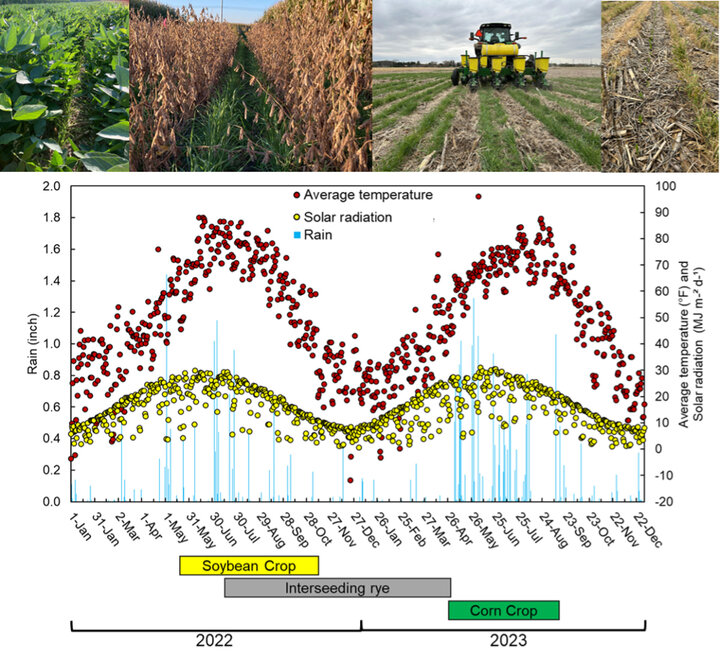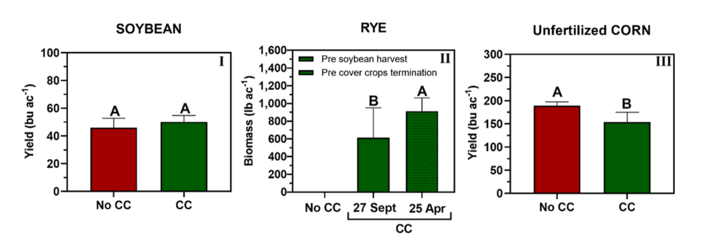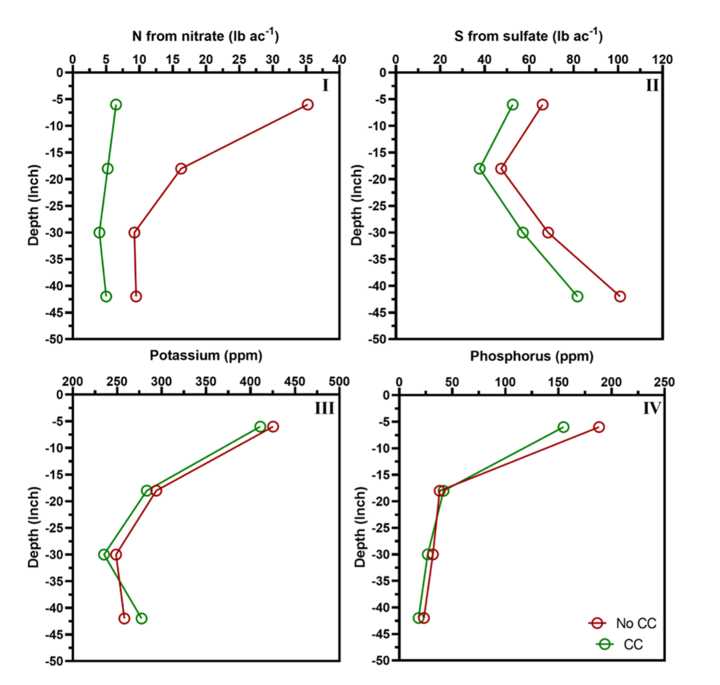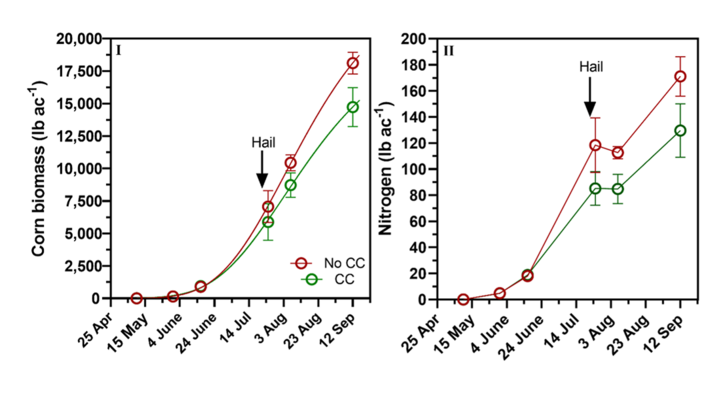Cover crops are increasingly being used as a strategy to promote soil health and farming system sustainability in Nebraska and the United States. Cover crops can provide important ecosystem services such as reduction in soil erosion and nutrient loss, increased nutrient use efficiency, fixation of atmospheric nitrogen (N2) through symbiosis with legume species, improved soil quality and weed control from residue cover.
Farmers commonly drill cover crops after soybean harvest and sometimes after corn. For corn, there is an opportunity to drill cover crops in between rows via interseeding early season between V2-V6 stage (two to six fully developed leaves) or broadcast cover crop seed late in the season at the R5.5 (full dent) corn stage.
In soybean, cover crops can be drilled after harvest or broadcasted late in the season. Unlike in corn, the interseeding of cover crops into soybean with an adapted drill before R2 stage (full flowering) in 30-inch row spacing setting has not been widely tested. Also, farmers still have questions regarding cover crop water use, variety selection, seeding rate, seeding timing, the negative impact of residual herbicides on cover crop establishment, and the possible impact of the cover crops in the current (soybean) and following (corn) cash crop yield. The objective of this study was to test how interseeding cover crops into soybeans affects soybean seed yield and nutrient dynamics for the following corn crop.
The experiments were conducted in 2022 (soybean) and 2023 (corn) at West Central Research, Extension and Education Center (WCREEC) in North Platte, Nebraska, under central pivot irrigation. Weather conditions and crop sequence during the study are shown in Figure 1.
In 2022, soybeans were planted at 180,000 seeds per acre (30-inch row spacing) on May 19, and cereal rye was interseeded mid-season, July 13, at the R2 stage of soybean. There were two cereal rye seeding rate treatments of 60 pounds seed per acre and 120 pounds seed per acre, and a control treatment without a cover crop. The results of 60 pounds and 120 pounds of seeds per acre treatments were combined and analyzed together, due to no statistically significant difference between these two seeding rates on the variables analyzed. Hereafter, we reference treatments as cover crop (CC) and no cover crop (no CC).

The soybean herbicide program included a pre-emergence (May 11, 2022) of 3.5 ounces per acre Fierce® (Flumioxazin + Pyroxasulfone) and one quart per acre glyphosate, and post-emergence application (June 8, 2022) of Engenia® (dicamba) at 12.8 ounces per acre and Clethodim at eight ounces per acre.
Cover crop aboveground biomass was collected two times: before soybean harvest (Sept. 27, 2022), and prior to CC termination right before corn planting (April 25, 2023). The soybean was harvested on Nov. 10, 2022, and yield was recorded (Figure 2).

In 2023, corn was planted at 32,000 seeds per acre on May 16. Soil sampling was performed in April before corn planting to assess nutrients, especially nitrogen (N) available for corn. Aboveground corn biomass was also collected during the season to track crop N dynamics on CC vs. no CC situation (Figure 3). No fertilizer was applied to corn during the season to quantify how much N the previous cover crop was providing the corn crop. Corn was harvested on Sept. 11, 2023 and yield is reported in Figure 2.
In 2022, mid-season cereal rye interseeding did not show signs of residual herbicide carryover from pre- and post-emergence application, regardless of the potential residual carryover of Clethodim (300 days in soil with pH 7-8 such as the experimental soil). There is a concern by producers that herbicides can negatively impact cover crop establishment throughout the crop season. However, cereal rye drilled over a month after the post-emergence herbicide application in this study emerged and resulted in a satisfactory biomass production of 613 pounds per acre before soybean harvest (Figure 2 – panel II).
It is worth mentioning that, during soybean harvest, part of this interseeded cover crop biomass was cut by the combine. Thus, if the purpose of the cover crop is for grazing in the fall after soybean harvest, some time for CC regrowth needs to be allowed. On the other hand, more testing with interseeding cover crops into soybean is needed to understand their growth and impact on soybean harvest, as fresh green plant material could impact combine performance and possibly soybean harvest moisture, which was not the case in this experiment.
In this study, the soybean seed yield was not affected by the interseeded cover crop, which is a desirable output considering the cover crop's ability to suppress weeds and produce biomass for grazing or building soil organic carbon pools or capturing payments for utilizing cover crops through climate smart initiatives (Figure 2 – panel I). In April 2023, the cover crop aboveground biomass before termination was collected and it showed total biomass production of 914 pounds per acre (Figure 2 – panel II). The corn yield in 2023 on no CC treatment was greater than the CC treatment, denoting that part of the nutrients were immobilized by the cereal rye interseeded in 2022.
In April 2023, soil sampling was performed before corn planting and our findings show that nitrate content in pounds per acre on no CC treatment across the four depths sampled of 12, 24, 36 and 48 inches was greater than the CC treatment (Figure 3 – panel I). Unlike other nutrients, soil N was largely depleted by the CC treatment in the upper two feet, suggesting cereal rye can capture a decent amount of nitrate surplus in the upper portion of the soil, even with low biomass production. Our measurements indicate that 29 pounds of N per acre in the first foot and 11 pounds of N per acre in the second foot were immobilized in CC in comparison to no CC (Figure 3 – panel I).

The soil sulfate also showed CC immobilization throughout the soil profile (approximately 13 pounds of S per acre per foot), which implies the need for an integrated and balanced nutrient management when utilizing cover crops (Figure 3 – panel II). Other macronutrients such as potassium and phosphorus did not show significant changes in their soil availability due to the presence of cover crops (Figure 3 – panel III and IV).
The biomass and N dynamics on CC vs no CC denote an offset that was not overcome during the growing season. The biomass and the N content of corn were higher in the no CC condition compared to the CC treatment. This confirms that the cereal rye in the CC treatment immobilized some of the available soil N and did not fully release it to the corn during the growing season. The amount of final N uptake difference between CC and no CC (41 pounds of N per acre) was about the same as the one found immobilized by the CC in the soil (49 pounds of N per acre). Consequently, corn yield decreased by 37 bu per acre in the CC treatment (Figure 2 – panel III). This stresses the need for on-farm experimentation to see whether the CC will affect corn yield (most likely in cases of low N rates) or will capture residual/unused N.
Still, this experiment shows soil capacity to provide N. The corn crop under irrigation with no supplemental N produced 154 and 189 bu ac-1 in the CC and no CC, respectively. This indicates that the soil alone, where the experiment took place, provided the corn crop with 139-170 pounds of N during the growing season, considering that corn uses around 0.9 pounds of N to produce a bushel of grain. Corn yields also would have been higher in this experiment if a hailstorm hadn’t occurred on July 22, 2023.

Learnings from Interseeding Cover Crops into Soybean
- It is possible to interseed cereal rye on soybean interrow up to the R2 stage in west-central Nebraska. However, it is not a recommended practice for the first time establishing a cover crop.
- Cereal rye rates of 60 and 120 pounds of seed ac-1 had the same effects. Lower rates than 60 pounds of seed ac-1 should be tested to find the most cost-effective seeding rate.
- The interseeded cover crop showed a great ability to retain nitrates and sulfur but did not modify the available phosphorous and potassium in the soil. These results indicate the need for an integrated and balanced nutrient management when utilizing cover crops in the crop sequence to avoid yield penalties due to nutrient competition of cover crop with the following crop.
- The immobilized N in the interseeded cover crop was not fully available for the following corn crop in the experimental conditions of no N fertilizer additions to the corn. The continuous use of cover crops may bring nutrients to balance, but the benefits were not observed during the same year.
- Some soils in west-central Nebraska can provide a relatively large amount of N (139-170 pounds N per acre) without the addition of N fertilizer. Knowing the soil capacity with an unfertilized plot/strip can help to fine-tune cost-effective N fertilizer rates.
